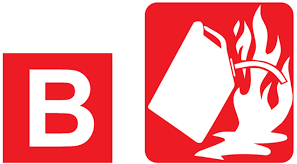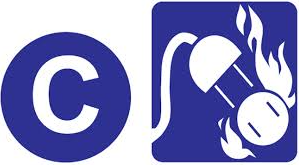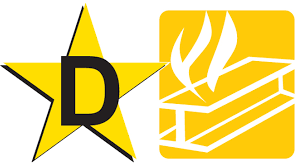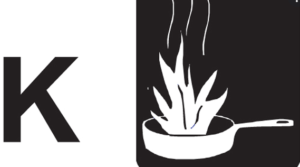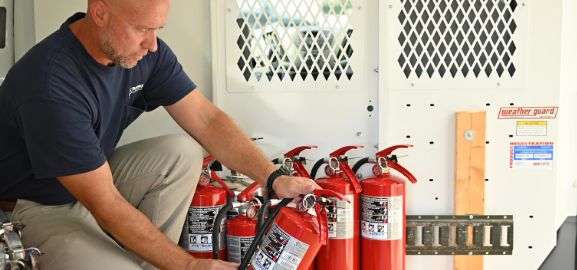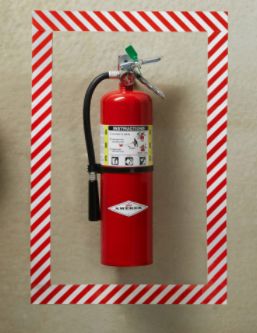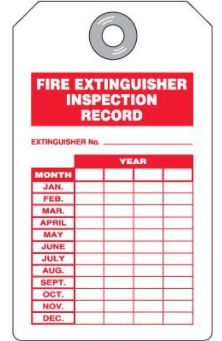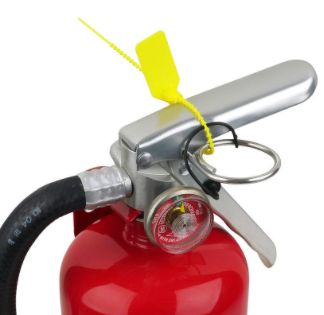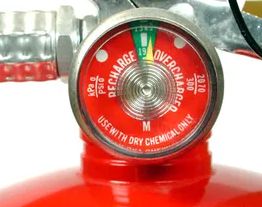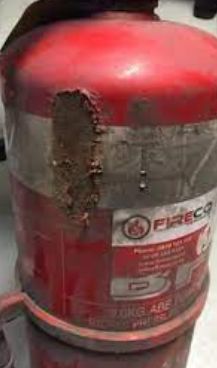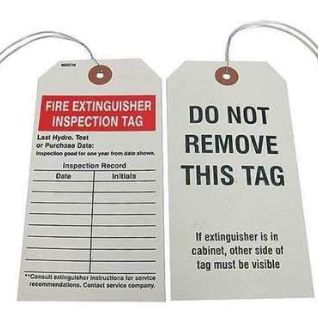Fire Extinguisher
The thought of a fire can be terrifying, especially if you are not educated on what to do in case one breaks out. Thankfully, fire extinguishers exist! These devices help put the flames out and protect people and property.
This article will discuss everything you need to know about these life-saving tools, including how they work, types of extinguishers available when appropriate to use them, safety tips for using them properly and more!
It is important to have working fire extinguishers at home and in public locations, including businesses, schools and other buildings frequented by many people each day! If you are a business owner, your employees must be trained on using a fire extinguisher. In addition, it is important to have an evacuation plan in place in case of a fire emergency.
Before we learn about fire extinguishers, we need to understand five different types of fire, so let’s start
Class of Fire
Class A Fires |
|
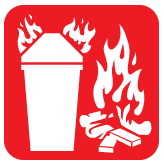 |
Some fires occur in normal fire-prone materials like cloth, paper, wood as well as rubber and other plastics. |
Class B Fires |
|
 |
Inflammable liquids, such as petroleum greases, gasoline and oils, tars, solvents, oil-based paints, alcohols, or flammable gases like butane and propane.
This does not include fires involving cooking oils or grease. |
Class C Fires |
|
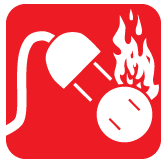 |
The fires that occur are caused by energised electrical equipment, including servers, computers motors, transformers, and appliances.
If you remove the power, the Class C fire can be classified as an additional type of fire. |
Class D Fires |
|
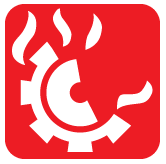 |
Inflammation can occur commonly in combustible metals such as zirconium, titanium, magnesium as well as lithium, sodium and potassium.
|
Class K Fires |
|
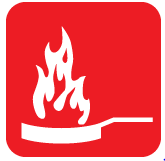 |
The fires common in cooking oil or greases, including vegetable and animal fats. also known as kitchen fire extinguisher |
When purchasing a fire extinguisher, it is important to consider the type of fire you are most likely to encounter. There are five common household fires: paper, grease, electrical, chemical and wood, and each type requires a different fire type of extinguisher.
Type of Fire Extinguisher
There are eight common types of fire extinguishers: water, foam, CO2, powder, water mist, Clean Agent, Cartridge Operated Dry Chemical and wet chemicals. There are different types of fire extinguishers suitable for different types of fire.
Dry Chemical Fire Extinguishers
Dry fire extinguishers made of chemicals put out the flame by disrupting the chemical reaction of the triangle.
The most commonly used kind of fire extinguisher is a multi-purpose dry chemical that works on Classes A, B as well as C-type fires. The agent also functions by forming barriers between the oxygen and fuel elements in class A flames.
Dry chemical normal is intended for Classes B and C exclusively. It is essential to select the appropriate extinguisher for the kind of fuel! The incorrect choice of agent may cause the fire to restart after it was extinguished.
Water and Foam Fire Extinguishers
Foam and water fire extinguishers eliminate the flame by removing all fire’s heat elements in the fire triangle. Foam agents also differentiate oxygen from oxygen elements from other elements.
The water extinguishers are designed for class A only, and they are not recommended for Class B or C fires. The discharge stream can cause the spread of the flammable liquid in the case of a Class B fire or could cause shock hazards in a Class C fire.
Carbon Dioxide Fire Extinguishers (CO2)
Carbon dioxide extinguishers for fire smother the flame by eliminating the oxygen part of the fire triangle and eliminating all heat through a cold discharge.
Extinguishers for carbon dioxide are effective for class B or C flames. They are generally ineffective for Class A fires.
Water Mist Fire Extinguishers
Water mist extinguishers eliminate flames by eliminating the fire’s heat component of the triangle of fire. They can be used instead of the clean agent extinguishers when contamination is a major concern.
Extinguishers for water mist were designed to be used for Class A fires. However, they are suitable for use in Class C fires too.
Wet Chemical Fire Extinguishers
The wet chemical can put out the fire by removing the heat generated by the triangle of fire and preventing the spread of flames by creating an oxygen barrier between the fuel and oxygen elements.
Our chemical, also known as Class K extinguishers, have been designed to work with modern, high-efficiency deep fat fryers used in commercial kitchens. Some may also be used for Class A fires in commercial kitchens.
Cartridge Operated Dry Chemical Fire Extinguishers
Cartridge controlled Dry chemical extinguishers for fires smother the fire by interrupting the chemical reaction of the triangle.
Similar to the dry chemical stored under pressure extinguishers, this multi-purpose dry chemical works well in Class A B and C fires. The agent also functions to create a wall between elements of oxygen and fuel of Classes A and B fires.
A dry, normal chemical is intended for class B or C flames exclusively. It is crucial to select the right extinguisher to match the fuel type! The incorrect choice of agent could cause the fire to re-ignite after it was extinguished.
Dry Powder Fire Extinguishers
Dry powder extinguishers have a similar design as dry extinguishers made of chemicals. They put out the fire by segregating their fuel from the oxygen element or taking away all heating elements from the fire triangle.
Dry powder extinguishers can be used for class D or non-combustible metallic fires. They are not effective on other kinds of fires.
Clean Agent Fire Extinguishers
Extinguishers that are clean or hydrogenated comprise the halon extinguishers along with the latest and less ozone-depleting halocarbon agents. They put out the fire by halting this chemical process or removing heat from the fire triangle.
Clean agent extinguishers work on Class A B, C and A fires. Smaller sized handheld extinguishers may not be sufficient to warrant a 1A rating and could carry the Class B or C rating.
Fire Extinguisher Symbols Label
Have you ever seen symbols on a fire extinguisher and wondered What do the Symbols on a Fire Extinguisher Indicate?
To help bring you out of the darkness and into the light of fire prevention, here is this quick and easy guide to reading fire extinguisher labels!
Class A
Class A Fire extinguisher are designed for normal combustible substances like wood, paper, cardboard and a majority of plastics. The numerical rating of these extinguishers is the quantity of water they hold and the quantity of fire they can put out. The geometric symbol for class A is a triangle in green.
Class B
Class B fires are caused by the use of flammable or combustible liquids like gasoline, kerosene, grease, and oil. The numerical rating of extinguishers in class B will indicate the approximate number in square feet it is able to eliminate. The symbol that indicates class B is an orange square. Here is detailed information about Class B Fire Extinguisher
Class C
Class C fires are caused by electrical equipment, including wiring, appliances, circuit breakers, outlets and other electrical equipment. Do not use water to put out the class C fires as the danger of electric shock is too severe!
Class C Extinguisher do not have any numerical rating, and the C classification indicates that the extinguishing agent is not conductive. The symbol that indicates class C is blue circles.
Class D
Class D fire Extinguisher can be often used in chemical laboratories. They are designed for fires that are explosive to metals such as titanium, magnesium, and sodium. These kinds of extinguishers don’t have any numerical rating or an additional rating for multi-purpose use – they are intended to be used only for class D fires.
The symbol that represents class D is the yellow decagon.
Class K
Extinguishers for fires of Class K are used for the fires caused by trans-fats, cooking oils, or cooking equipment that use fats and are commonly located in cafeterias and restaurants kitchens. The symbol that signifies class K is a black hexagon. You can also check detailed guide of Class K Fire Extinguisher with video training.
How to Use a Fire Extinguisher
Experts in fire safety recommend learning how to use an extinguisher before an emergency. Ask your local fire department if they offer homeowner training. Keep your extinguishers near the exit of the room so you can easily see them.
This will allow you to fight the flames with your back towards the door and quickly escape from the room if they get out of control. you can check out complete and step by step details of How to Use a Fire Extinguisher? with video guide.
Residents should remember the word PASS when using a fire extinguisher
- Pull the pin – Hold the extinguisher with the nozzle pointing away from you and release the locking mechanism.
- Aim the nozzle at the base of the fire
- Squeeze the handle of the fire extinguisher
- Sweep the nozzle from side to side.
Tips to Use a Fire Extinguisher
You will be able to operate a fire extinguisher properly once you have mastered the differences and their uses.
It is important to know the steps to prepare for an emergency in your home.
Find a clear escape/exit route
Make sure that you have an evacuation route in place before using the fire extinguisher. You will need to exit safely if you cannot put out the flames. This is a key consideration when deciding where to keep your fire extinguisher. Also, please make sure there are multiple exit options available after you have retrieved it.
Remain calm
Face the fire, and keep your back towards the exit you identified earlier. As you prepare to use the fire extinguisher, you must stay at least six to eight feet from the flames.
Discharge extinguisher
During an emergency, it cannot be easy to think clearly. For this reason, fire safety has a long-standing acronym that helps you remember how to operate your fire extinguisher. When extinguishing a fire, you should PASS as shown above.
Keep an eye out for things
Once the flames have died out, keep an eye on the fire to ensure it doesn’t rekindle. Repeat the PASS procedure if the fire rekindles.
Contact the fire department
You should call the fire department immediately if you haven’t had the opportunity to do so before you discharge the fire extinguisher. They will inspect the area and ensure that the fire is extinguished completely.
Move to a safe area
If the fire has been extinguished or if you are unable to extinguish the fire, move to a safe area.
Fire Extinguisher Maintenance and Inspection
In case you’re not sure when you’ll need a fire extinguisher, you probably want to know that if there’s a fire, it’s going to work and hopefully extinguish it. Every month, make sure you check your house’s fire extinguishers. The following tips on fire extinguisher maintenance will help you keep your extinguishers charged and ready to go when you need them.
Steps for Inspecting Fire Extinguisher
Ensure you read the instructions and user guide before purchasing a fire extinguisher. You may find that they differ slightly from one extinguisher to another. Also, you might find that there are specific maintenance and inspection requirements for fire extinguishers. You will likely find instructions for mounting it to a wall specific to your unit.
Ensure You Have Easy Access
The ability to respond quickly is a key strategy for fighting any fire. Quickly responding can be aided by attaching the fire extinguisher to the wall near any potential fire source. These areas are a good place to mount clearly-visible fire extinguishers.
- Other than rooms that contain furnaces, HVAC systems, and water heaters
- Around fireplaces
- In The Kitchen
- Garage – Make sure that the extinguisher is rated for cold temperatures if necessary
- Outdoor near the grill or outside kitchen
Check the Fire Extinguisher Inspection Tag
You have a lot of things to consider when assessing the condition and upkeep of an extinguisher. If the extinguisher comes with one, this tag will be attached to the neck. Tie a piece of cardboard to the extinguisher, and make your notes. This is a great way of quickly noting down the inspection date and some notes about the extinguisher’s condition. You can find the date of the last inspection on the fire extinguisher tag.
Confirm that the Hose and Pin are in Place
Each component of an extinguisher has a specific role. They all work together to put out fires quickly. The pin and hose are key components. They help direct the chemical spray and prevent accidental release. To discharge the chemical in most cases, pull the safety pin. Next, point the hose at the flames and squeeze the handle to release the fire-fighting chemical.
Replace the hose if you notice cracks or it is too fragile to bend easily. If an extinguisher comes with a safety tie, ensure that the pin is secured to it. The tether may be missing, or the extinguisher may have been used.
Gauge the Pressure
To combat a fire, an extinguisher must perform at its best. An extinguisher that isn’t properly charged may not work well or at all, such as when it is needed to extinguish a barbecue fire. Fire extinguishers should be regularly inspected and recharged as needed. Here are the details about your extinguisher’s pressure gauge (or charge):
- The gauge’s indicator should point only to the “charged” green zone
- A high-powered extinguisher could pose an explosion risk
- A fire extinguisher that is too charged may not be able to emit enough fire retardant to put out a fire
Look for physical damage.
Check the gas canister for any dents before inspecting the extinguisher. If the paint is scuffed or has divots, it could have suffered a fall and is leaking slowly. Another sign of trouble is rust around the neck and seal between the canister.
Update the Inspection Tag
After reviewing the fire extinguisher’s condition, update the inspection tag with today’s date and any notes you want to be on the lookout for the next month. This will allow you to keep track of any issues that may arise over the year.
Reference
- National Fire Protection Association (NFPA): Fire extinguishers
- NFPA Educational Messages Desk Reference











